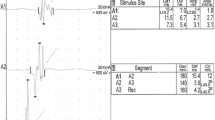Abstract
The gross and histopathological findings in the brain and spinal cord of five Alaskan Husky dogs with a novel incapacitating and ultimately fatal familial and presumed hereditary neurodegenerative disorder are described. Four dogs presented with neurological deficits before the age of 1 year (7–11 months) and one animal at 2.5 years old. Clinical signs in all dogs were of acute onset and included ataxia, seizures, behavioral abnormalities, blindness, facial hypalgesia and difficulties in prehension of food. In animals allowed to survive, the disease was static but with frequent recurrences. Pathological findings were limited to the central nervous system. Grossly visible bilateral and symmetrical cavitated foci were consistently present in the thalamus with variable extension into the caudal brain stem. Microscopic lesions were more widespread and included foci of bilateral and symmetrical degeneration in the basal nuclei, midbrain, pons and medulla, as well as multifocal lesions at the base of sulci in the cerebral cortex and in the gray matter of cerebellar folia in the ventral vermis. Neuronal loss with concomitant neuronal sparing, spongiosis, vascular hypertrophy and hyperplasia, gliosis, cavitation and transient mixed inflammatory infiltration were the main histopathological findings. In addition, a population of reactive gemistocytic astrocytes with prominent cytoplasmic vacuolation was noted in the thalamus. Lesions of this nature in this distribution within the neuroaxis have not been reported in dogs. The neuropathological findings resemble Leigh’s disease/subacute necrotizing encephalomyelopathy of man. Neuronal sparing in conjunction with apparently transient astrocytic vacuolation point to the possible pathogenetic role of astrocytes in the evolution of these lesions. An inherited metabolic derangement of unknown nature is postulated as the cause of this breed-specific disorder.
Similar content being viewed by others
Author information
Authors and Affiliations
Additional information
Received: 6 August 1999 / Revised, accepted: 18 October 1999
Rights and permissions
About this article
Cite this article
Brenner, O., Wakshlag, J., Summers, B. et al. Alaskan Husky encephalopathy – a canine neurodegenerative disorder resembling subacute necrotizing encephalomyelopathy (Leigh syndrome). Acta Neuropathol 100, 50–62 (2000). https://doi.org/10.1007/s004010051192
Issue Date:
DOI: https://doi.org/10.1007/s004010051192




